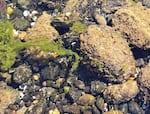Earlier this week, Clark County Public Health received a report of possible benthic algae mat material along the Columbia River shoreline at Cottonwood Beach in Washougal. Staff visited the beach and found algae that appear similar to the ones that caused a dog’s death in October.
The county has not received reports of illness linked to algae exposure at Cottonwood Beach, and it’s unclear whether that algae contains potentially harmful toxins for people and pets.
“As a precaution, Public Health has posted educational signs about benthic algae mats at Cottonwood Beach,” Clark County said in a statement Friday. “And Public Health is urging residents to check for potentially harmful algae anytime they are recreating in and along the Columbia River and other waterbodies this summer.

Toxic benthic algae mats could look like this, in this image provided by Clark County.
Clark County
Following the deaths of two dogs last year, Clark County is alerting the public to a new form of cyanobacteria found in the Columbia River: benthic algae mats.
The county first learned of this new bacteria in October 2024, when a dog’s death was attributed to cyanotoxin poisoning. The dog had previously spent time on Ackerman Island in the Columbia River. Another dog also died from the same bacteria in August 2024 near St. Helens, Oregon, Clark County later learned.
But there was no visible algae bloom at the Port of Camas-Washougal, Columbia River or Ackerman Island — at least, not the kind the general public is aware of.
Outbreaks of cyanobacteria and other forms of life in waterways can “bloom” in large numbers and produce toxins that make people and animals sick. In recent years, the Columbia River has become increasingly prone to blooms of cyanobacteria, more commonly known as blue-green algae.
According to Clark County, these well-known planktonic algae blooms are typically mixed into the water column, can collect in scum on the surface, and often accumulate at or near the shoreline. As they get more dense, they can reduce water clarity, and are more often found in ponds, lakes and slow-moving water.
Benthic algae mats, however, are often attached to the bottom of waterways in mats, blobs or spires, or detached and floating in clumps. They can occur anywhere in a fast or slow-moving water body, do not affect water clarity, and can feel slimy, gelatinous or slippery.

Left: planktonic algae blooms in Lacamas Lake, Oct. 10, 2022, in an image provided by Clark County. Right: benthic algae mats, in an image provided by Benton-Franklin Health District. Clark County first learned of benthic algae mats in October 2024, when a dog’s death was attributed to cyanotoxin poisoning.
Clark County/Benton-Franklin Health District
Both planktonic algae blooms and benthic algae mats can produce potentially harmful levels of toxins. As summer approaches, it’s also important to remember that cyanobacteria thrive in warmer waters.
Clark County Public Health advises the public to check for cyanobacteria in water. Do not let dogs, adults or children touch, eat or swallow any algal mats. And do not let dogs drink from the water you believe algal mats to be in.
Illness symptoms may occur in people and dogs within minutes to a few hours after contact with toxic algae mats. Clark County has provided a full list of symptoms on their website.
